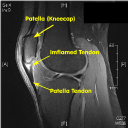Patellar Tendinitis
Patellar Tendinitis is a common and well recognised cause of knee pain. It is commonly seen in athletes and runners but can also occur in the more sedentary.
Typically patients will report pain in the front of the knee, just below the patella (Knee cap), after strenuous or repeated activity. In more extreme cases, symptoms become intrusive into day to day activities. Often patients will complain that it stops them doing certain activities or tasks. The pain may described as burning or sharp in nature.
What is it exactly?
Patellar tendinitis is basically an inflammation of the tendon that runs from the knee cap to the shinbone. Usually it is most severe close to the kneecap itself but can affect the whole of the tendon. Diagnosis is usually easy with the typical history and localised tenderness just below the knee cap. MRI scanning will confirm the diagnosis and rule out other causes.
How is it treated?
For most people, conservative or non-
Who needs Surgery?
In some patients, even with extended conservative treatment, symptoms fail to settle. If after a suitable period of time, symptoms are still bad, then a surgical approach can be considered .Often this can be performed arthroscopically though tiny incisions as a day case procedure. Several procedures are described, but removal of the top most inflamed layer of the tendon seems to promote healing.
Are there any other alternatives?
Other less invasive techniques are in development, such as “Dry needling” and “PRP (platelet rich plasma) injections.
These procedures invoke a healing response in the affected part of the tendon without the need to surgically invade the joint.The major advantage is the avoidance of surgery and anaesthesia, but medium to long term results probably do not match surgical treatment. They are worth trying prior to surgery in selected patients
Click to enlarge
| Personal Details |
| Orthopaedic Surgical Team |
| Personal Results |
| Background Information |
| Sports Injury |
| Arthritis |
| Surgical Guides |
| Pre Operative Guides |
| Post Operative Guides |
| Alexandra Hospital |

